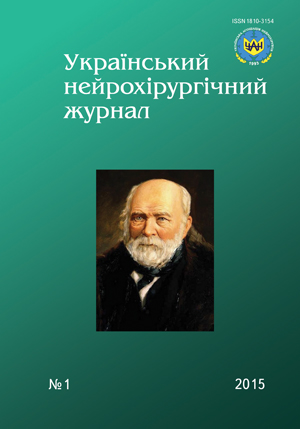Changes of ceruloplasmin and malonic dialdehyde level in patients with cerebral circulatory disorders
DOI:
https://doi.org/10.25305/unj.42667Keywords:
acute cerebral circulatory disorders, ceruloplasmin, malonic dialdehyde, cytoflavinAbstract
The purpose. To study role of ceruloplasmin and malonic dialdehyde in pathogenesis of hepatocerebral dystrophy. Changes of malonic dialdehyde concentration in the blood serum indicate the increase of lipid peroxidation intensity and failure of antioxidant protection system.
Materials and methods. 30 patients with acute hemorrhagic cerebral circulatory disorders caused by saccular aneurysms rupture with different localization were examined. Patients in the 1st group received combined therapy and Citoflavin, in the 2nd group — received just combined therapy.
Results. Ceruloplasmin level increased in all terms of observation in patients who received Cytoflavin and approached to normal as opposed to indicators after combined therapy, indicating energy metabolism disorders. Malonic dialdehyde concentration significantly increased, even in comparison with early stages of the study, indicating a failure of homeostasis compensatory possibilities, which was not observed at Cytoflavin application.
Conclusions. Cytoflavin use contributed to normalization of ceruloplasmin level in the early and middle periods of observation with preservation of these indicators in a remote period. Under the influence of Citoflavin level of malonic dialdehyde was close to normal in the medium and remote periods of the study.
References
Nikonov VV, Pavlenko AYu, Beletskiy AV, Krivobokov VI. Tsitoflavin v korrektsii gomeostaza u patsiyentov v ostrom periode politravmy [Cytoflavin in correction of homeostasis in patients in acute period of polytrauma]. Meditsina Neotlozh Sostoyaniy. 2012;1(40):47-51. Russian.
Klocheva EG. Primeneniye preparata Tsitoflavin v nevrologii: Posobiye dlya vrachey [Citoflavin in Neurology: A guide for doctors]. Sankt-Peterburg: Taktik-Studio;, 2009. Russian.
Isakov VA, Arkhipov GS, Aspel YuV. Novyy neyrotsitoprotektor tsitoflavin v terapii neyroinfektsii [New neurocytoprotektor cytoflavin in therapy of neuroinfection]. Vestn SPbGMA im II Mechnikova. 2003;1–2:105–109. Russian.
Tsitoflavin: Sb. nauch. statey, opubl. v 2006-2007 gg [Citoflavin: Collection of scientifical articles publ. in 2006-2007]. Sankt-Peterburg: NPF Polisan, 2008. Russian.
Rudolphi K, Schubert P. Modulation of neuronal and glial cell function by adenosine and neuroprotection in vascular demential. Behavioural Brain Research. 1997;83(1-2):123-128. CrossRef.
Liu Y, Yang C, Chen M, Sun S, Tzeng S. Ca 2+ -dependent reduction of glutamate aspartate transporter GLAST expression in astrocytes by P2X 7 receptor-mediated phosphoinositide 3-kinase signaling. Journal of Neurochemistry. 2010;113(1):213-227. CrossRef.
Haskó G, Pacher P, Sylvester Vizi E, Illes P. Adenosine receptor signaling in the brain immune system. Trends in Pharmacological Sciences. 2005;26(10):511-516. CrossRef.
Afanasyev VV, Lukyanova IYu. Osobennosti primeneniya tsitoflavina v sovremennoy klinicheskoy praktike [Features of the application cytoflavin in modern clinical practice]. SanktrPeterburg: TaktikrStudio, 2010. Russian.
Zaychik ASh, Churilov LP. Osnovy Patokhimii [Basis of Pathologic Chemistry]. Sankt-Peterburg: Elbi;2000. Russian.
Yudenkova OA, Zhukov VA. Primeneniye tsitoflavina v pervyye chasy razvitiya ostroy tserebrovaskulyarnoy ishemii [Application cytoflavin in the first hours of acute cerebrovascular ischemia]. Vrach. 2006;5:67-70. Russian.
Klimantsev SA, Afanasyev VV, Lukyanova IYu. Dogospitalnaya neyrotsitoprotektsiya [Prehospital neurocytoprotection]. In: Proceedings of the V All-Russian Conference of Emergency Physician; 2009 Oct 15-17; Санкт-Петербург, Russian.
Rumyantseva SA. Neyroprotektivnaya terapiya ishemii mozga [Neuroprotective therapy of cerebral ischemia]. In: Proceedings of the conference «Treatment of brain ischemia»; 2001 Dec 10; Moscow, Russian. Moscow: RGMU. p.32-36. Russian.
Vashchenko VI, Vashchenko TN. [Сeruloplasmin - from metalloprotein to drug]. Psychopharmacology and Biological Narcology. 2006;6(3):1254-1269. Russian.
Tyukavkina NA, Baukov YuI. Bioorganicheskaya khimiya [Bioorganic Chemistry]. 4th ed. Moscow: Drofa, 2005. Russian.
Bankova VV. Rol malonovogo dialdegida v regulyatsii perekisnogo okisleniya lipidov v norme i patologii [The role of malondialdehyde in the regulation of lipid peroxidation in health and disease] [dissertation]. [Moscow]: Scientific Research Institute of Nutrition; 1990. Russian.
Metody klinicheskikh laboratornykh issledovaniy [Methods of clinical laboratory tests]. Kamyshnikov VS, editor. 6th ed. Moscow: MEDpress-inform; 2013. Russian.
Gavrilov VB, Gavrilova AR, Mazhul' LM. [Methods of determining lipid peroxidation products in the serum using a thiobarbituric acid test]. Vopr Med Khim. 1987;33(1):118-22. Russian.
Downloads
Published
How to Cite
Issue
Section
License
Copyright (c) 2015 Sergiy Minov, Olena Mironenko, Oleksandr Parkhomenko, Oleksandr Zhurahivskiy

This work is licensed under a Creative Commons Attribution 4.0 International License.
Ukrainian Neurosurgical Journal abides by the CREATIVE COMMONS copyright rights and permissions for open access journals.
Authors, who are published in this Journal, agree to the following conditions:
1. The authors reserve the right to authorship of the work and pass the first publication right of this work to the Journal under the terms of Creative Commons Attribution License, which allows others to freely distribute the published research with the obligatory reference to the authors of the original work and the first publication of the work in this Journal.
2. The authors have the right to conclude separate supplement agreements that relate to non-exclusive work distribution in the form of which it has been published by the Journal (for example, to upload the work to the online storage of the Journal or publish it as part of a monograph), provided that the reference to the first publication of the work in this Journal is included.









